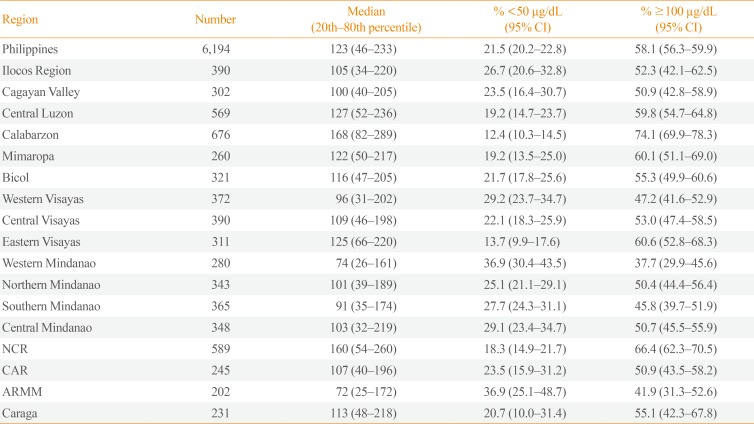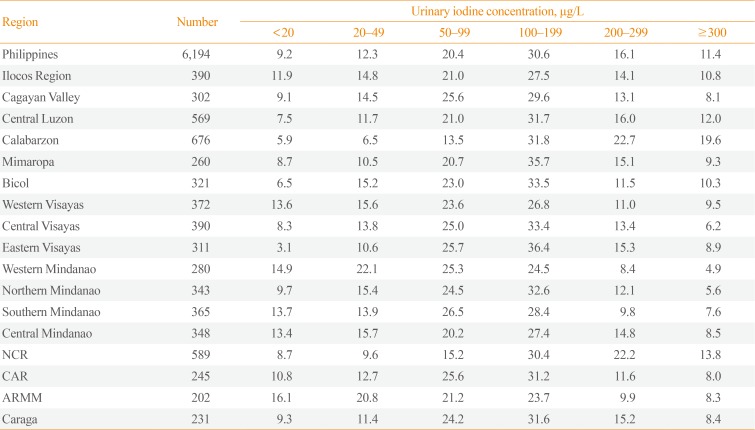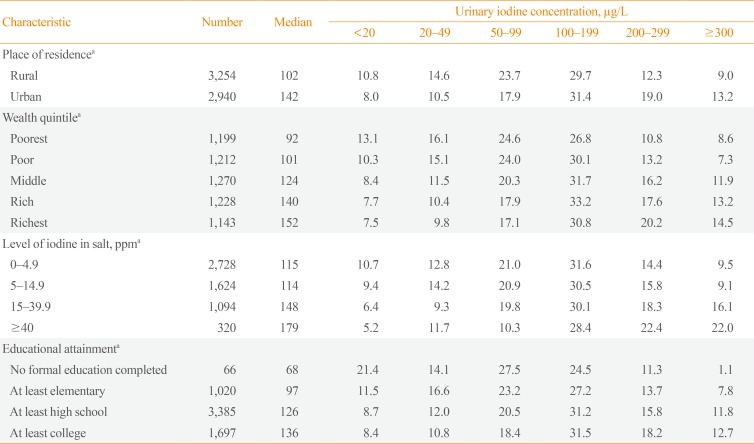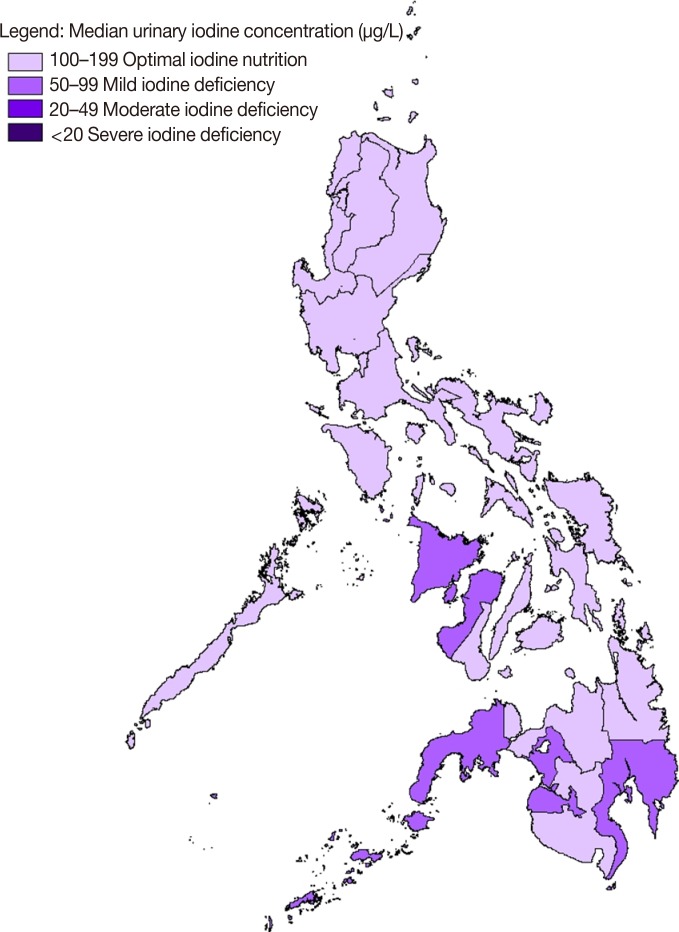1. International Council for Control of Iodine Deficiency Disorders. UNICEF. World Health Organization. Assessment of iodine deficiency disorders and monitoring their elimination. 3rd ed. Geneva: World Health Organization;2007.
2. Bath SC, Steer CD, Golding J, Emmett P, Rayman MP. Effect of inadequate iodine status in UK pregnant women on cognitive outcomes in their children: results from the Avon Longitudinal Study of Parents and Children (ALSPAC). Lancet. 2013; 382:331–337. PMID:
23706508.

3. Hynes KL, Otahal P, Hay I, Burgess JR. Mild iodine deficiency during pregnancy is associated with reduced educational outcomes in the offspring: 9-year follow-up of the gestational iodine cohort. J Clin Endocrinol Metab. 2013; 98:1954–1962. PMID:
23633204.

4. Glinoer D. The importance of iodine nutrition during pregnancy. Public Health Nutr. 2007; 10:1542–1546. PMID:
18053277.

6. Perlas LA, Ulanday JRC, Marcos JM, Serafico ME, Desnacido JA, Alibayan MV, et al. Iodine deficiency disorder among Filipino school children, pregnant and lactating women and the elderly 20 years after the Act for Salt Iodization Nationwide Law. J Endocrinol Metab. 2017; 7:86–93.

7. Caldwell KL, Pan Y, Mortensen ME, Makhmudov A, Merrill L, Moye J. Iodine status in pregnant women in the National Children's Study and in U.S. women (15–44 years), National Health and Nutrition Examination Survey 2005-2010. Thyroid. 2013; 23:927–937. PMID:
23488982.

8. Pan Y, Caldwell KL, Li Y, Caudill SP, Mortensen ME, Makhmudov A, et al. Smoothed urinary iodine percentiles for the US population and pregnant women: National Health and Nutrition Examination Survey, 2001-2010. Eur Thyroid J. 2013; 2:127–134. PMID:
24783051.

9. Stagnaro-Green A, Abalovich M, Alexander E, Azizi F, Mestman J, Negro R, et al. Guidelines of the American Thyroid Association for the diagnosis and management of thyroid disease during pregnancy and postpartum. Thyroid. 2011; 21:1081–1125. PMID:
21787128.

10. Mills JL, Buck Louis GM, Kannan K, Weck J, Wan Y, Maisog J, et al. Delayed conception in women with low-urinary iodine concentrations: a population-based prospective cohort study. Hum Reprod. 2018; 33:426–433.

11. Council for International Organizations of Medical Sciences (CIOMS). International ethical guidelines for epidemiological studies. Geneva: CIOMS;2008.
12. Philippine Council for Health Research and Development-Department of Science and Technology. Philippine National Ethical Guidelines for Health Research, 2011. Taguig: Philippine National Health Research System;2011.
14. Pino S, Fang SL, Braverman LE. Ammonium persulfate: a safe alternative oxidizing reagent for measuring urinary iodine. Clin Chem. 1996; 42:239–243. PMID:
8595717.

15. Lumley T, Scott AJ. Two-sample rank tests under complex sampling. Biometrika. 2013; 100:831–842.

16. Morreale de Escobar G, Obregon MJ, Escobar del Rey F. Role of thyroid hormone during early brain development. Eur J Endocrinol. 2004; 151(Suppl 3):U25–U37. PMID:
15554884.

17. Chan S, Kilby MD. Thyroid hormone and central nervous system development. J Endocrinol. 2000; 165:1–8. PMID:
10750030.

18. Glinoer D, Delange F. The potential repercussions of maternal, fetal, and neonatal hypothyroxinemia on the progeny. Thyroid. 2000; 10:871–887. PMID:
11081254.

19. Delange F. Iodine deficiency as a cause of brain damage. Postgrad Med J. 2001; 77:217–220. PMID:
11264481.

20. Donnay S, Arena J, Lucas A, Velasco I, Ares S. Working Group on Disorders Related to Iodine Deficiency and Thyroid Dysfunction of the Spanish Society of Endocrinology and Nutrition. Iodine supplementation during pregnancy and lactation. Position statement of the working group on disorders related to iodine deficiency and thyroid dysfunction of the Spanish Society of Endocrinology and Nutrition. Endocrinol Nutr. 2014; 61:27–34. PMID:
24035326.

21. Preedy VR, Burrow GN, Watson R. Chapter 62, Iodine deficiency and the brain: an overview. Comprehensive handbook of iodine. Amsterdam: Academic Press;2009. p. 598–606.
23. Rohner F, Wirth JP, Woodruff BA, Chiwile F, Yankson H, Sesay F, et al. Iodine status of women of reproductive age in Sierra Leone and its association with household coverage with adequately iodized salt. Nutrients. 2016; 8:74. PMID:
26848685.

24. Kartono D, Atmarita A, Jahari AB, Soekirman S, Izwardy D. The situation of urinary iodine concentration (UIC) among school age children, women at reproductive age and pregnant women in Indonesia: the analysis of Riskesdas 2013. Gizi Indon. 2016; 39:49–58.
25. Burns K, Yap C, Mina A, Gunton JE. Iodine deficiency in women of childbearing age: not bread alone. Asia Pac J Clin Nutr. 2018; 27:853–859. PMID:
30045431.
26. Land MA, Webster JL, Ma G, Li M, Su'a SA, Ieremia M, et al. Salt intake and iodine status of women in Samoa. Asia Pac J Clin Nutr. 2016; 25:142–149. PMID:
26965773.
27. Edmonds JC, McLean RM, Williams SM, Skeaff SA. Urinary iodine concentration of New Zealand adults improves with mandatory fortification of bread with iodised salt but not to predicted levels. Eur J Nutr. 2016; 55:1201–1212. PMID:
26018655.

28. Kshatri JS, Karmee N, Tripathy RM. Prevalence and predictors of poor iodine nutrition in rural South Odisha: a comparative study between coastal and hilly districts. Natl J Community Med. 2017; 8:41–46.
29. Konrade I, Neimane L, Makrecka M, Strele I, Liepinsh E, Lejnieks A, et al. A cross-sectional survey of urinary iodine status in Latvia. Medicina (Kaunas). 2014; 50:124–129. PMID:
25172607.

30. Wang Z, Zhu W, Mo Z, Wang Y, Mao G, Wang X, et al. An increase in consuming adequately iodized salt may not be enough to rectify iodine deficiency in pregnancy in an iodine-sufficient area of China. Int J Environ Res Public Health. 2017; 14:E206. PMID:
28230748.

31. Costa Leite J, Keating E, Pestana D, Cruz Fernandes V, Maia ML, Norberto S, et al. Iodine status and iodised salt consumption in Portuguese school-aged children: the iogeneration study. Nutrients. 2017; 9:E458. PMID:
28475154.

32. Knowles JM, Garrett GS, Gorstein J, Kupka R, Situma R, Yadav K, et al. Household coverage with adequately iodized salt varies greatly between countries and by residence type and socioeconomic status within countries: results from 10 national coverage surveys. J Nutr. 2017; 147:1004S–1014S. PMID:
28404840.

33. Garnweidner-Holme L, Aakre I, Lilleengen AM, Brantsaeter AL, Henjum S. Knowledge about iodine in pregnant and lactating women in the Oslo area, Norway. Nutrients. 2017; 9:E493. PMID:
28505075.

34. Charlton KE, Yeatman HR, Houweling F. Poor iodine status and knowledge related to iodine on the eve of mandatory iodine fortification in Australia. Asia Pac J Clin Nutr. 2010; 19:250–255. PMID:
20460240.








 PDF
PDF ePub
ePub Citation
Citation Print
Print




 XML Download
XML Download